Can You See Cat Pee With Black Light
Occasionally customers have issues locating pet urine with their PeeDar or other blacklights. Here we'll detail how to quickly check your light works, then we'll provide a more in-depth look at all the major causes of reduced fluorescence, and finish with some key methods of identifying the source of a glow.
Before you go any further, first ensure your PeeDar's light is a constant, strong light blue colour on standard white printer/writing paper.
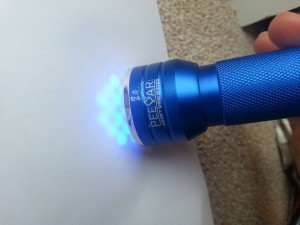
All LEDs should be producing light of roughly the same intensity. If not, or you believe your unit is faulty in some other way, contact us and we can discuss issuing a free replacement!
Reduced/non-existent fluorescence is most likely to have come from some or all of the following:
- Insufficiently dried urine (the usual culprit!) – as it dries urine starts to increasingly, constantly, wick water moisture from its surroundings, whether it's in a liquid form or moisture in the air. Humid air (e.g. from bathrooms, kitchens), wet absorbent materials, and regular pet urination (esp. larger animals) in/near the last urine patch can significantly reduce glows, in some cases to zero.
To see glows, secure the suspect area from animals/people/moisture-producing things so it has time to dry. In cases of potentially large amounts of urine, such as when it has seeped through many layers of carpet or deep into furniture you may literally need to dry the area for a few days, or up to a week at normal room temperature. Dry urine has a much more crystalline structure which is able to provide the greatest glows possible. If you can stomach the smell, faster drying may be achieved by novel methods of removing moisture, e.g. hair-drying or using a portable filament heater safely and carefully aimed at the edge of a wet stain.
Moisture meters are a good extra tool for locating wet (or dried – due to its wicking nature it is always at least a tiny bit wet!) urine. You can also ask your vet about "fluorescein", it's ingested by your pet, and peed out over a few days, fluoresces very brightly in wet or dry urine, and has the added advantage of being able to reveal individual problem pets and where they go. Remember too that neighbour's pets can sometimes be the source of your urine woes. Cats have been known to visit other people's homes to eat their pet cat's food, amongst other possible antics. Dogs sometimes urinate in other people's homes, such as when a dog owner invites a friend's nervous/territorial/poorly trained dog round to play with their own dog.
- Low surface areas of dried urine – carpets have much larger surface areas for urine to dry on and then react with UV. Tiles, on the other hand, often emit less glows due to thinner layers of urine, and the ease with which urine can be cleaned/worn away.
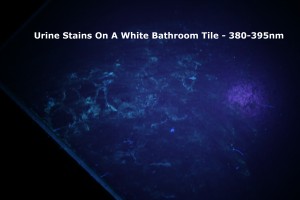
- Majority of urine absorbed below the surface – common on furniture as well as other highly absorptive objects, urine can be absorbed deep below the surface with very little if any detected at the surface.
- Used/low power batteries – PeeDar LEDs use a lot of battery power. Used batteries can deliver markedly lower UV light output and therefore the resultant weaker glows can make finding urine stains difficult.
- Urine that naturally fluoresces very little – some pets are reported to have urine that naturally doesn't fluoresce much if at all under UV, and usually not much can be done about this. Ingestion of large quantities of water is known to cause pets to pee out the chemicals in urine that create the yellow colour that seems to be responsible for fluorescence under UV.
One way to assess glow strength is by absorbing wet urine onto dry white tissue, shining your PeeDar on it once dry. Weaker glows will let you know searches should be slower and more methodical.
- Dark or patterned surfaces – darker colours absorb more light, reducing glows. During tests we've performed dark carpet colours such as deep blue and rich red did prove problematic, some glows were not detectable! Patterns make seeing edges of glows more difficult. Other types of glowing stains that cover suspect areas, such as those from cleaning fluids or some types of food, can also add to the confusion.
- Similarly glowing surfaces – although we've yet to see this, the sheer range of carpets on sale inevitably mean that some may glow with near enough the same intensity as your pet's urine, this could make detecting contrasts, especially with weak glowing urine, quite difficult. Lighter coloured carpets, often of the same colour as dried urine, could create glows under UV.
Interestingly, at least from our experience, whitish coloured carpets (see our product's before and after photos) are great for detecting dried urine. Lighter flooring colours naturally reflect more light away through the dried urine, this filters much of the visible light into the glow colours of the urine. Outlines are also more visible since the glowing surrounds are strongly a different glow colour to the urine. Such lighter carpets also have the added bonus of actually showing up some stains in normal daylight.
- Incorrectly tinted glasses – from tests we've performed, under 385nm any tint colours/shades in glasses, UV-protective or not, reduce the contrast of stains against their backgrounds, making stains harder to spot. We recommend using zero tinted 99% UV protective safety glasses when hunting for invisible urine stains with your PeeDar flashlights. If you've got a cheaper 390nm+ UV flashlight then we'd generally recommend yellow/amber coloured safety glasses, they tend to increase the contrast by cutting out the normally overpowering obscuring strong purple visible light.
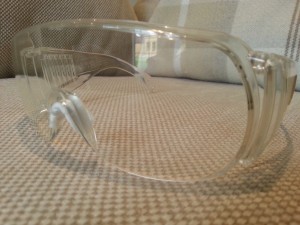
- Not searching in complete darkness – although obvious, only by searching in pitch black conditions will you be giving yourself the best chance of seeing the full spectrum of glows at their brightest, from vivid and intense colours to the very faintest glows from older stains.
- Not searching in the right areas – sometimes you'll smell the stains yet see nothing. This could well be because you simply have not looked around hard enough! Pets can appear to be very creative with where they urinate. Cats in particular can sometimes pee in the most seemingly unlikely places, such as on book shelves, behind doors and under tables or settees.
Lastly, finding the source of the glowing material can be difficult, UV lights simply highlight all fluoresce-able substances. We know that urine in general has a mid-to-low intensity glow compared with other fluorescing things, and is a light yellowy-white/straw colour. Cat urine can often have a faint light green tinge. Cat urine glows usually have spray or pool-shaped outlines, sprays are usually on more vertical surfaces, regular urination is typically on horizontal surfaces. Cat urine often has a very pungent ammonia smell too. Dog urine reportedly usually has less of an ammonia stench, older stains can sometimes not give off much smell, but generally all urine is usually unmistakable when sniffed close enough. Dog puke can appear as a dull/faint yellow/mustard colour. Cleaning fluids have among the strongest glows possible, often from their bleach component, and are usually a brilliant white or whitish purple/blue. Food glows are highly variable, from nothing to extremely vivid (e.g. Thai green curry glows a very strong straw/light greenish colour). Some juices such as orange juice show up as a deep red. This is a complex area as you are probably beginning to see.
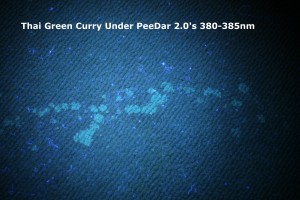
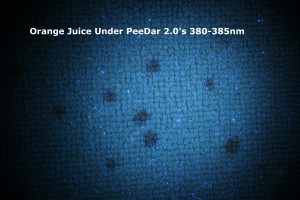
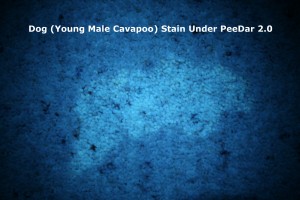
When using your PeeDar with our advice and your natural senses, we're sure you'll be able to locate and eradicate all your pet's mistakes with relative ease. Please do tell us how you get on!
Can You See Cat Pee With Black Light
Source: http://www.urineeradicationsystems.com/dog-cat-urine-removal/why-does-my-uv-light-not-make-urine-glow-1373/
0 Response to "Can You See Cat Pee With Black Light"
Post a Comment